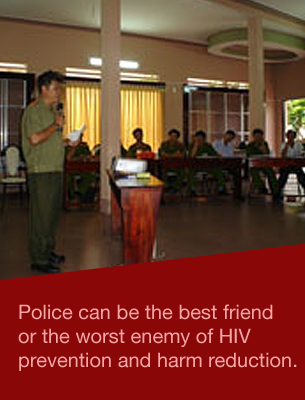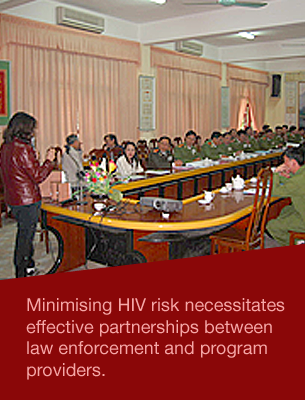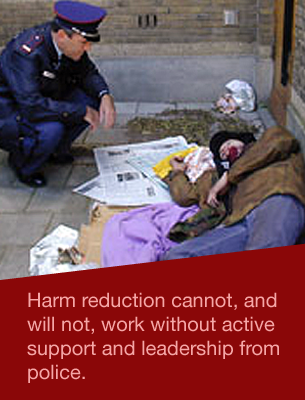|
HARM REDUCTION ADVISORY No 1 November 2013 |
|
Concerns regarding new estimates on HIV, hepatitis C and injecting drug use Summary In June 2013, the UN Office on Drugs and Crime released estimates on HIV, hepatitis C and injecting drug use within the annual World Drug Report (WDR). The 2013 report presents ‘new data’ that it claims reflects a global ‘decline’ in the number of people who inject drugs since the 2008 figures published by the Reference Group to the United Nations on HIV and Injecting Drug Use. In particular, this ‘updating’ of the 2008 data claims a ‘decline’ in the number of people who inject drugs living with HIV worldwide from 3 million to 1.6 million. As the publisher of The Global State of Harm Reduction, the main independent NGO resource on the international response to HIV and injecting drug use, Harm Reduction International raised immediate concerns to UNODC about this data, in particular the use of language and graphics that attributes these considerable differences to actual changes in the HIV epidemic among people who inject drugs since 2008. As a result, UNODC released an online statement clarifying that, ‘lower estimates [in the WDR] do not represent a decrease in the epidemic, but an improved availability of more reliable data’. However, despite this online clarification the official WDR has not been similarly amended to ensure that the data is not misrepresented or misinterpreted. Harm Reduction International (HRI) has raised further concerns about whether the WDR figures are in fact based upon the ‘improved availability of more reliable data’, as information on how national data were derived remains out of the public domain, and due to a potential over-reliance on government self-reporting. This lack of transparency coupled with a limited peer review process, led HRI to question the data, and following discussions with UNODC regarding these concerns, to our decision not to use the data within HRI reports. HRI welcomes UNODC’s commitment to improving the collection of global data on HIV and injecting drug use, including through increased collaboration with other UN agencies on this work and the establishment of a new Strategic Advisory Group. However, pending a transparent peer-reviewed process to gather such data, HRI will continue to refer to global estimates from the Reference Group to the UN on HIV and Injecting Drug Use within the Global State of Harm Reduction programme of work. This advisory outlines the reasons for that decision. 1. Language and graphics The 2013 World Drug Report presents a new figure of 1.6 million people globally who inject drugs and live with HIV. This is a significantly lower figure than the 3 million estimated by the UN Reference Group in 2008. The World Drug Report presents this figure as an actual decline since 2008 in the numbers of people injecting drugs and the extent to which HIV affects them. In the executive summary, the report states that ‘New data reveal that the prevalence of people who inject drugs and those who inject drugs and are also living with HIV in 2011 was lower than previously estimated: 14.0 million people between the ages of 15 and 64 are estimated to be injecting drugs, while 1.6 million people who inject drugs are living with HIV. This reflects a 12 per cent decline in the number of people who inject drugs and a 46 per cent decline in the number of people who inject drugs that are living with HIV since the 2008 estimates’. (Page ix, Emphasis added). Figures 4, 5, 6 and 7 (6 and 7 displayed below) graphically compare the differences between national data from 2008 and 2011 as ‘increases’ and ‘decreases’ over time. For example, it is suggested that HIV prevalence among people who inject drugs in Russia has decreased by almost half, and that there has been a decrease of over 350,000 people who inject drugs living with HIV, in three years. This encourages the reader to compare data that is likely to be incomparable due to differing data collection methodologies. The WDR presentation of the data also allows for the erroneous conclusion that current efforts have had significant success in reducing the HIV epidemic among people who inject drugs globally. This is far from an accurate reflection of the current state of harm reduction[1]. It is at best misleading, and at worst has the potential to weaken advocacy for increased political, financial and programmatic commitment to harm reduction, as well as much needed policy change in key countries where the injecting-drive HIV epidemic is most acute. 2. Methodology and peer review The UNODC dataset used for the WDR is available online. For many countries the source of the data is not provided, and for over one-third of the dataset, ‘government’ or ‘ARQ response’ is listed as the source. The limitations of the responses to the annual review questionnaire or ARQ, submitted by governments, as a source of data are described within the WDR methodology description (also available online). These are not open to the public, which means that this data cannot be openly tested or questioned. The lack of information on the original data source also limited the extent to which the dataset could be peer-reviewed. Poor transparency and a limited peer review process, coupled with a potential over-reliance on government self-reporting, leaves the reliability of the World Drug Report data open to question. 3. Harm Reduction International’s response These data on HIV and injecting drug use inform national responses around the world. They are important for programme planning and evaluation, resource allocation and advocating for programmes that prevent and treat HIV among people who inject drugs. They have a direct bearing on the emphasis harm reduction receives compared with competing budgetary priorities of governments and international donors. The independence and transparency of the process used to collect this data is of vital importance, particularly while government commitment remains a considerable challenge to preventing HIV among people who inject drugs. The utmost rigour, care and scrutiny are required in data gathering, analysis and in dissemination of the data implications. As the leading international NGO tracking injecting drug use, HIV and the harm reduction response worldwide, Harm Reduction International has initiated discussions within our sector on the World Drug Report data. Based upon internal and external consultation and review, we have come to the following decisions:
Harm Reduction International advice on use of this data
Further sources for data on HIV, hepatitis C and injecting drug use include:
[1] For example, UNAIDS (2013) Global report: UNAIDS report on the global AIDS epidemic 2013. Geneva: UNAIDS p30-7; Harm Reduction International (2012) Global State of Harm Reduction 2012. London: Harm Reduction International. This is the first in HRI’s new series of ‘Harm Reduction Advisories’. HRI advisories are short information notes for the harm reduction sector focusing on emerging issues that are of interest to partners around the world. The advisory series seek to address emerging and pertinent issues in harm reduction policy, practice and research relating to specific themes, interventions or substances. The advisories will be produced periodically in consultation with experts from around the world and circulated via HRI’s e-list. www.ihra.net/contents/1426 |












The Global State of Harm Reduction 2012 presents the major developments in harm reduction policy adoption and programme implementation that have occurred since 2010. It also explores several major topics for developing an integrated harm reduction response, such as effective harm reduction services for women who inject drugs; access to harm reduction services by young people; drug use among men who have sex with men and implications for harm reduction; global progress toward building an enabling policy environment for harm reduction implementation through drug decriminalisation and regulation; case studies on sustainability and scale-up of services; and promotion of harm reduction approaches in challenging environments.
The illegal nature of injection drug use can also create barriers to accessing adequate treatment and prevention services making IDUs more vulnerable to HIV and its effects. Without adequate access to HIV testing and prevention services, there is a high risk that HIV will also be transmitted to the sexual partners of people who inject drugs. The crossover of drug use with sex work further means that HIV is likely to be transmitted to other at risk populations and their partners.
Thanks for your comment. You highlight some pertinent points about factors contributing to HIV risk. LEAHN works with police all over the world to improve police practices regarding drug law enforcement due to the barriers to treatment caused by the illegal nature of injection drug use. If you know of any programs which have positive police involvement, please let us know. We try to highlight these programs so positive police engagement can become more widespread and police can contribute to preventing HIV instead of carrying out practices which exacerbate it. Best regards.
This fact sheet provides a snapshot of the HIV epidemic among people who inject drugs in Canada. It is one of a series of fact sheets on the epidemiology of HIV and hepatitis C.
The searches yielded a total of 5981 studies of mortality related to the use of opioids, amphetamines and cocaine. We identified another 79 articles by searching the reference lists of reviews on mortality related to drug use. Experts provided additional studies for 16 cohorts. From these 5981 articles we excluded a total of 5762: 4999 did not focus on drug dependence or mortality, 118 did not include raw data, 292 were case series, and 600 had insufficient mortality data on people who inject drugs. In total, we selected 67 cohort studies for inclusion in the analyses (Fig. 1). These studies were further assessed using STROBE reporting guidelines.